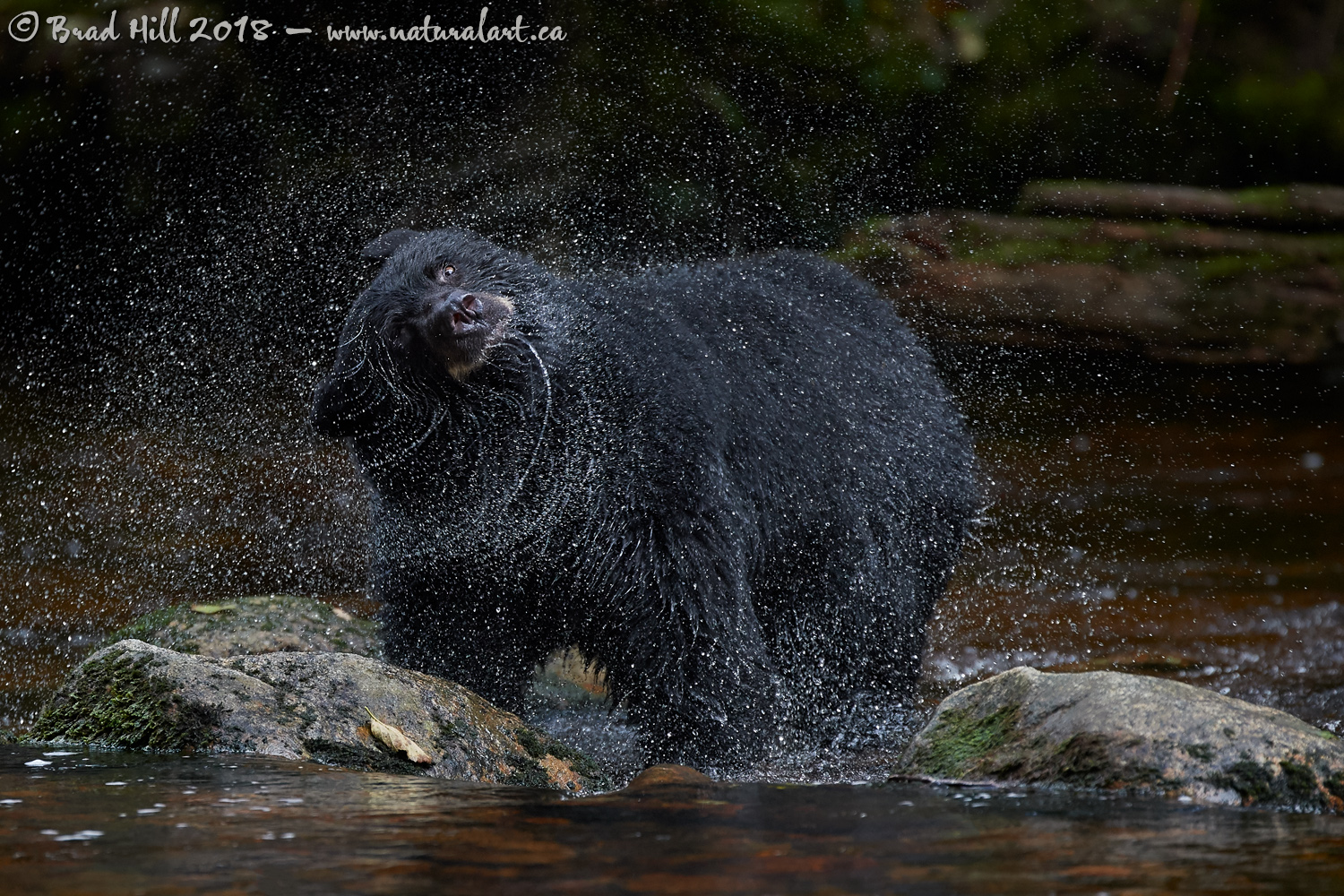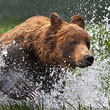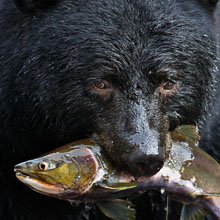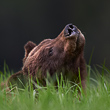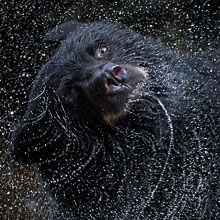Availability: Undetermined - Enquiries?
In the Field
The Spin Cycle. Great Bear Rainforest, Northern BC Coast, Canada. September 27, 2017.
I captured this "fun" shot of a Black Bear shaking water off its head in the autumn of 2017 in BC's famous Great Bear Rainforest. While I've seen bears shake hundreds of times I'm still drawn to it and I still love photographing it. I seem to go in phases on action shots - at times I get into a "motion blur" phase and other times I seem to spontaneously shift into "freeze the action" mode. Obviously this shot came about when I was in a "freeze the action" phase!
I've seen bears shake when walking on dry land during a rainstorm, but more often than not it seems to happen when bears get wet up to (and possibly get water IN) their ears. This bear had just soaked its entire head when it dove into a shallow pool in a stream during a failed attempt to catch a salmon. I got lucky in this case in that defused sunlight (through light overcast sky) was illuminating the bear (and the water streaming off it's head) but the background was deep in shadow. So the natural contrast in the scene was very high - just the way I like it!
I captured this scene using one of my current favorite low-light wildlife photography camera and lens set-ups - a Nikon D5 paired up with Sigma's 120-300mm f2.8 Sport lens. Even with the lens almost wide open (f3.5) I still needed a fairly high ISO (4000) to get the shutter speed needed to freeze the action. If I had been shooting a lens with a f4 (or smaller) maximum aperture I would have needed to use an ISO which - at least for some cameras - would have been in the "very iffy" range! ;-)
Another thing I like about this lens is that even at the long end of the focal range (this shot right at 300mm) and almost wide open (f3.5) it's still VERY sharp - even when viewed at 100% magnification the original full-resolution version of this shot is very sharp. Anyone who has used the Sigma 120-300 f2.8 Sport lens will know it isn't "svelte" (which is a nice way of saying it's on the heavy side) but for me the optical quality and build quality of the lens more than offset the weight. I'm beginning to think of this lens as one of my "secret weapons" for wildlife shooting (to this day I'm still shocked by how many wildlife photographers are unaware of its existence!). In order to keep this secret I'm making a point of NOT telling anyone how much I use (and like) this lens! ;-)
Here's a larger (2400 pixel) version of this shot for your perusal:
• The Spin Cycle: Download 2400 pixel image (JPEG: 2.1 MB)
ADDITIONAL NOTES:
1. This image was captured during my autumn"Into the Great Bear Rainforest" Instructional photo tour in the summer of 2017. Each year I offer photo tours into several different parts of the Great Bear Rainforest as well trips to photograph marine mammals and oceanscapes in locations on the northern portion of Vancouver Island. And, in selected years, I also offer photo tours to locations to capture other highly sought-after subjects, such as Dall Sheep, Bald Eagles, and more. Details about these trips can be found on the Photo Tours page of this website.
2. This image - in all resolutions - is protected by copyright. I'm fine with personal uses of them (including use as desktop backgrounds or screensavers on your own computer), but unauthorized commercial use of the image is prohibited by law. Thanks in advance for respecting my copyright!
3. Like all wildlife photographs on this website, this image was captured following the strict ethical guidelines described in The Wildlife FIRST! Principles of Photographer Conduct. I encourage all wildlife photographers to always put the welfare of their subjects above the value of their photographs.
Behind the Camera
The Spin Cycle. Great Bear Rainforest, Northern BC Coast, Canada. September 27, 2017.
Digital Capture; Compressed RAW (NEF) 14-bit format; ISO 4000.
Nikon D5 paired with Sigma Sport 120-300mm f2.8 Sport lens @ 300mm. Hand-held. OS on and in "OS1" mode, with OS1 stabilization customized to Moderate View mode; AF customized to Fast Priority AF.
1/1250s @ f3.5; -1-0 stop compensation from "recommended" matrix-metered exposure setting.
At the Computer
The Spin Cycle. Great Bear Rainforest, Northern BC Coast, Canada. September 27, 2017.
RAW Conversion to 16-bit TIFF, including all global and selective adjustments using Phase One's Capture One Pro 11. Selective local adjustments accomplished using Capture One Pro's layers and masking tools. In this case adjustments were made on 7 separate layers and included local/selective editing or application of noise reduction, exposure, colour desaturation, contrast (via a curves adjustment) and shadow recovery.
Photoshop adjustments were limited to image re-sizing, conversion of Prophoto RGB colour gamut (to sRGB), final sharpening for online display, and insertion of watermark.
Conservation
The Spin Cycle. Great Bear Rainforest, Northern BC Coast, Canada. September 27, 2017.
Ten percent of the revenue generated by this image will be donated to Raincoast*.
Species Status in Canada**: Not currently listed as Threatened or Endangered.
This black bear is a member of the subspecies "Kermodei" (Ursus americana kermodei). This subspecies is unique in that the population is characterized by having an unusually high proportion of a recessive gene that produces white coat colour (found on the "Spirit Bears"). Because the Black Bear is not considered under threat as a species, both the Kermodei subspecies and the very rare Spirit Bear suffer from having the same conservation designation (it should be acknowledged that in British Columbia - the jurisdiction of greatest Spirit Bear abundance - hunting of these white-coated bears is not permitted). For reasons that are not fully understood, the Spirit Bear occurs with greater frequency in a relatively small geographic area within The Great Bear Rainforest of the central and northern coast of British Columbia. In this area 10 to 30% of the bears possess white coats. Many of the black-coloured Black Bears in this region carry the gene for white coats, so allowing hunting of ANY Black Bears in this region can reduce the frequency of the gene for white coats. Thus, to protect the Spirit Bear, it is necessary to prohibit the hunting of ALL Black Bears in this region. And, very unfortunately, the globally unique ecosystem that contains the Spirit Bear is under development pressure, especially from the forestry industry. If this unique environment is altered, we may lose the wonderful genetic anomaly known as the Spirit Bear forever.
*The Raincoast Conservation Society (and Foundation) is an effective and efficient organization that has been fighting for protection of this unique habitat. If you are looking for a meaningful way to contribute to the conservation of this amazing ecosystem, Raincoast will provide maximal "bang" for your conservation dollars.
**as determined by COSEWIC: The Committee on the Status of Endangered Wildlife in Canada












